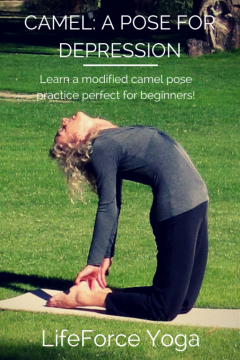
Research has shown that backbends are particularly good for lifting depressed mood. The full expression of this posture may be challenging if you are new to yoga, but you can practice a modified version, which I have described below. It’s important to warm-up the spine before doing a backbend practice. Make sure you have practiced the six movements of the spine and an easier backbend like sphinx pose before you try this posture. You can find these warm-up movements on the level one DVD, LifeForce Yoga to Beat the Blues. The six movements of the spine include spinal flexing, lateral movements and twisting in both directions. Camel Pose is beneficial for depression. After practicing this posture, you will feel lighter, brighter and ready for what life brings.
Camel Pose (Ustrasansa)
Camel Pose opens and expands the chest, lifts the spirits and increases lung capacity and blood circulation throughout the body. Try this posture only after you have warmed the body with gentle stretching for the muscles and flexing for the joints. You may wish to practice several exercises on your hands and knees. The “Six Movements for the Spine,” described in the Yoga Experience section at the end of Chapter Two of Yoga for Depression are good warm-ups to prepare the body for Camel pose. However, Camel pose is best practiced towards the end of your posture sequence, after the body is thoroughly stretched and relaxed.
Come into a kneeling position. Before you begin, roll your shoulders up and back several times, then reverse the direction, using the breath (inhaling up, exhaling down). This helps release the tension in your shoulders. Place your hands on your hips and slowly rotate your hips in one direction and then the other, noticing any tight places in your lower back. If there is tightness or soreness there, do not practice this pose, or modify it as I describe below. (As an alternative, you might give yourself a comfortable backbend by draping your back over a large exercise ball with your feet planted firmly on the floor.)
Place your hands at your sacrum with your fingers pointed down. Lift your chest and, if it is comfortable, let your head drop back. Press your pelvis forward and arch your back. This is the modified pose and you may hold right here, continuing to breathe long and deep through the nostrils.
If you wish to move into the full pose, lean back and place your right hand on your right heel, your left hand on your left heel. Keep pressing your pelvis forward and lifting your chest so that the weight of your body is not in your hands. Lifting the chest or sternum elongates the lumbar spine and reduces the curve making the posture safer and reducing the feeling of compression there. Breathe long and deep through the nostrils, inhaling for four counts and exhaling for four counts for eight breaths. You may also practice a cooling tone with this posture. The sound “A” soothes the heart. The low tone of “ee” cools the throat. The tone of “mmm” soothes the busy mind, right at the central medial cortex (third eye). You can practice these tones one at a time, and you can also roll them together. You can release the pose at any time, if the sensation grows too strong, or you can remain longer, if your body wishes a deeper experience. Listen to your body. This is a posture that stimulates the thymus gland and it is an excellent immune system builder. Camel Pose expands the chest and opens the heart.
To come out of the pose, slowly move your right hand to your lower back, then your left hand. When you feel complete, rest in child pose with your hips on your heels and your forehead on the floor. Let your arms come along side your body to relax your shoulders. You may wish to gently rock across your forehead, soothing the busy mind with the sound of “mmm.”
When you are ready, return to a sitting position, close your eyes, and notice how you feel.